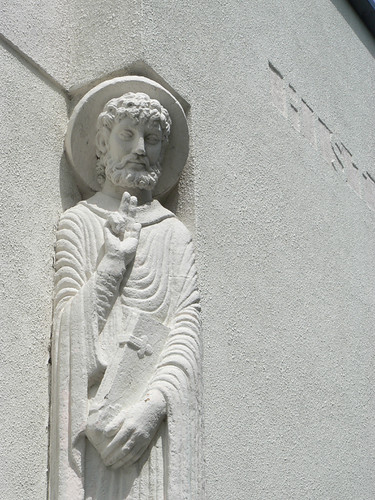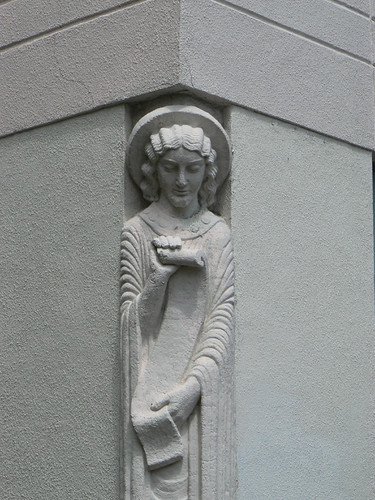 According to the Côte-des-Neiges booklet from the 10th World Congress on Art Deco in Montreal, it is difficult today, to find much information about the museum which occupied this building in a past life.
According to the Côte-des-Neiges booklet from the 10th World Congress on Art Deco in Montreal, it is difficult today, to find much information about the museum which occupied this building in a past life.
The building was built in 1935 and the architect was Paul M Lemieux.
The current occupant is a pharmacy chain and the doors enclosed in this large arch are no longer used but the words "Musée Historique Canadienne" can still be seen inscribed into the façade.
An unsual aspect of the building is a series of religious figures that stand in niches at the corners of the building. They don't appear to fit with the use of the building as a museum.
New Plans for Frank Lloyd Wright’s Price Tower
3 hours ago








































.jpg)















Great sculpture, David.
ReplyDeleteNot only is it surprising that religious subjects should be chosen for a national historical museum (as opposed to a museum of religious art, for example), but look at the style that was chosen. The figures remind me of a medieval cathedral like Chartres - long, biblical figures or saints, set in niches but almost free standing. And look at the drapes!
Hels
Thanks Hels.
ReplyDeleteThe way the material has been depicted in the stone really is fantastic.
The building is near St Joseph's Oratory so many that is where the religious connection comes in.
Hopefully someone will tell us one day.
I remember visiting the museum as a child -- in the 1950's. It was a wax mueum a la Madame Tussaud's. The figures populated dioramas which depicted scenes from Quebec history (remember this reflected a time when the Quebecois referred to themselves as "les canadiens"; anglo-Quebeckers were dismissed as "les anglais.")
ReplyDeleteI particularly remember the scene of Frontenac refusing the ultimatum to surrender Quebec to a fleet of British warships. Then there was a scene depicting Madelaine de Vercheres ...
There were also scenes taken from the New Testament and others depcitng the martyrs of the early Christian church. Remember this was a time when Quebec was a bastion of ultra-montaine Catholicism. That explains the religious statues on the outside of the building.
As a child I was quite impressed by the statues. I wonder where they are now and whether I would find them as convincing were I to see them again.
For several years following the closure of the museum, the upstairs housed a branch of the Comensal restaurant. It was there that I first met the woman who would become my wife.
Thank you so much Jonathan. It was so nice to read your first-hand experiences of the Museum and the restaurant that followed and learn a bit about the building.
ReplyDeleteDo you know when it closed?
Check the following URL:
ReplyDeletehttp://www.memorablemontreal.com/print/en/batiments_menu.php?quartier=6&batiment=212§ion=Array&menu=histoire
for some background information as well as postcards of the museum in its prime. It also indicates that the museum closed its doors in 1989.
If you understand French, I found a video clip from the archives of Radio Canada (the French CBC) dating from 1955, celebrating the museum's 20th anninversary. It shows some of the diorams. Apparantly there were some 24 scenes: 20 of the early church (among them a family of Christians about to be fed to the lions at the Coliseum) and four depicting the early days of New France. You will find it at:
http://archives.radio-canada.ca/societe/insolite/clips/14677/
Oh the memories!
Those links are fantastic Jonathan and fill in the gaps about the history of this building very nicely.
ReplyDelete